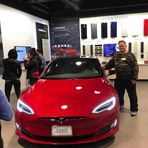The Tariff Storm: How Trump's Auto Policies Reshape the Industry Landscape
March 28, 2025, 10:45 am

Location: United States, Michigan, Ypsilanti
Employees: 10001+
Founded date: 1896
Total raised: $40K

Location: Netherlands, North Holland, Hoofddorp
Employees: 10001+
Founded date: 2021
Total raised: $331.53M

Location: United States, Texas, Austin
Employees: 10001+
Founded date: 2003
Total raised: $3.86B
The automotive industry is a vast ocean, and right now, it’s facing a tempest. President Donald Trump’s recent announcement of sweeping auto tariffs has sent shockwaves through this already turbulent sea. A 25% levy on cars not made in the United States threatens to reshape the landscape, leaving some companies afloat while others sink.
At the heart of this storm is Tesla, the electric vehicle (EV) maker that seems to be riding the waves rather than getting tossed about. Unlike many of its competitors, Tesla has a robust domestic production line. Analysts note that about 61% of Tesla's vehicle content comes from the U.S. This gives the company a unique advantage. While others scramble to adjust, Tesla stands firm, its sails catching the wind of opportunity.
In stark contrast, General Motors (GM) finds itself in choppy waters. The company’s reliance on imports, particularly from Mexico, has made it vulnerable. Approximately 30% of GM vehicles sold in the U.S. are assembled in Canada and Mexico. This heavy dependence on foreign production means that GM is feeling the brunt of the tariffs. Its stock plummeted over 7% following the announcement, a clear signal of investor anxiety.
Ford and Stellantis are also in the mix, but they are better positioned than GM. Ford, for instance, has a significant portion of its vehicles assembled in the U.S., which shields it from the worst of the tariff impacts. Stellantis, too, has a more balanced production strategy, with a majority of its vehicles made stateside.
The tariffs are a double-edged sword. While they aim to protect American jobs and bolster domestic manufacturing, they also risk inflating vehicle prices. Goldman Sachs estimates that car prices could rise by $5,000 to $15,000 if the tariffs remain in place. This could dampen consumer demand, creating a ripple effect throughout the industry.
Tesla’s unique position allows it to navigate these waters with relative ease. Its CEO, Elon Musk, has cultivated a close relationship with Trump, which may provide some insulation from the fallout. However, this connection could also be a double-edged sword. Musk’s ties to the administration might alienate international customers, particularly in Europe and Canada, where political sentiment is shifting against American brands.
In Europe, Tesla faces headwinds as subsidies dwindle and competition intensifies. The company’s growth trajectory could be hampered by these external factors, even as it thrives in the U.S. market. The irony is palpable: while Tesla may benefit from tariffs at home, it could suffer from a tarnished reputation abroad.
Meanwhile, GM’s challenges are compounded by its heavy reliance on foreign production. The company’s stock has already seen a significant decline this year, and the tariffs could exacerbate its struggles. Analysts warn that GM may need to rethink its production strategy to mitigate the impact of these tariffs.
The automotive landscape is shifting, and companies must adapt or risk being left behind. Tesla’s domestic production model is a blueprint for resilience. As competitors grapple with rising costs and supply chain disruptions, Tesla’s ability to source materials locally positions it as a leader in the industry.
The tariffs also raise questions about the future of the automotive market. Will consumers be willing to pay higher prices for vehicles? Or will they turn to alternatives, such as used cars or public transportation? The answers remain uncertain, but one thing is clear: the industry is at a crossroads.
As the storm rages on, companies must navigate these turbulent waters with caution. For Tesla, the challenge lies in maintaining its momentum while expanding its global footprint. For GM, the focus must shift to rebalancing its production strategy to lessen its reliance on imports.
The auto industry is a complex ecosystem, and the impact of these tariffs will be felt far and wide. From manufacturers to consumers, everyone has a stake in the outcome. As the dust settles, it will be interesting to see which companies emerge stronger and which ones falter.
In conclusion, the auto tariffs are more than just a policy change; they are a catalyst for transformation. The industry is evolving, and those who adapt will thrive. The storm may be fierce, but it also presents opportunities for growth and innovation. The key will be to steer through the chaos with a steady hand and a clear vision for the future.
At the heart of this storm is Tesla, the electric vehicle (EV) maker that seems to be riding the waves rather than getting tossed about. Unlike many of its competitors, Tesla has a robust domestic production line. Analysts note that about 61% of Tesla's vehicle content comes from the U.S. This gives the company a unique advantage. While others scramble to adjust, Tesla stands firm, its sails catching the wind of opportunity.
In stark contrast, General Motors (GM) finds itself in choppy waters. The company’s reliance on imports, particularly from Mexico, has made it vulnerable. Approximately 30% of GM vehicles sold in the U.S. are assembled in Canada and Mexico. This heavy dependence on foreign production means that GM is feeling the brunt of the tariffs. Its stock plummeted over 7% following the announcement, a clear signal of investor anxiety.
Ford and Stellantis are also in the mix, but they are better positioned than GM. Ford, for instance, has a significant portion of its vehicles assembled in the U.S., which shields it from the worst of the tariff impacts. Stellantis, too, has a more balanced production strategy, with a majority of its vehicles made stateside.
The tariffs are a double-edged sword. While they aim to protect American jobs and bolster domestic manufacturing, they also risk inflating vehicle prices. Goldman Sachs estimates that car prices could rise by $5,000 to $15,000 if the tariffs remain in place. This could dampen consumer demand, creating a ripple effect throughout the industry.
Tesla’s unique position allows it to navigate these waters with relative ease. Its CEO, Elon Musk, has cultivated a close relationship with Trump, which may provide some insulation from the fallout. However, this connection could also be a double-edged sword. Musk’s ties to the administration might alienate international customers, particularly in Europe and Canada, where political sentiment is shifting against American brands.
In Europe, Tesla faces headwinds as subsidies dwindle and competition intensifies. The company’s growth trajectory could be hampered by these external factors, even as it thrives in the U.S. market. The irony is palpable: while Tesla may benefit from tariffs at home, it could suffer from a tarnished reputation abroad.
Meanwhile, GM’s challenges are compounded by its heavy reliance on foreign production. The company’s stock has already seen a significant decline this year, and the tariffs could exacerbate its struggles. Analysts warn that GM may need to rethink its production strategy to mitigate the impact of these tariffs.
The automotive landscape is shifting, and companies must adapt or risk being left behind. Tesla’s domestic production model is a blueprint for resilience. As competitors grapple with rising costs and supply chain disruptions, Tesla’s ability to source materials locally positions it as a leader in the industry.
The tariffs also raise questions about the future of the automotive market. Will consumers be willing to pay higher prices for vehicles? Or will they turn to alternatives, such as used cars or public transportation? The answers remain uncertain, but one thing is clear: the industry is at a crossroads.
As the storm rages on, companies must navigate these turbulent waters with caution. For Tesla, the challenge lies in maintaining its momentum while expanding its global footprint. For GM, the focus must shift to rebalancing its production strategy to lessen its reliance on imports.
The auto industry is a complex ecosystem, and the impact of these tariffs will be felt far and wide. From manufacturers to consumers, everyone has a stake in the outcome. As the dust settles, it will be interesting to see which companies emerge stronger and which ones falter.
In conclusion, the auto tariffs are more than just a policy change; they are a catalyst for transformation. The industry is evolving, and those who adapt will thrive. The storm may be fierce, but it also presents opportunities for growth and innovation. The key will be to steer through the chaos with a steady hand and a clear vision for the future.
